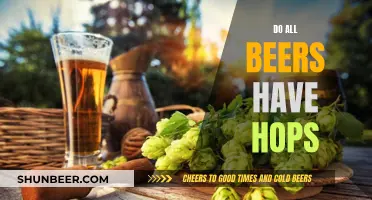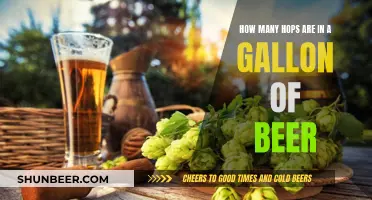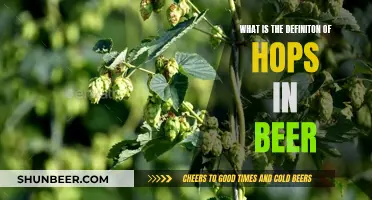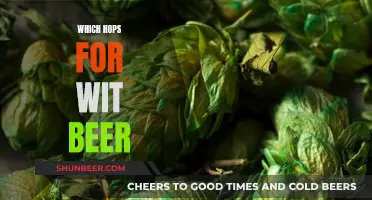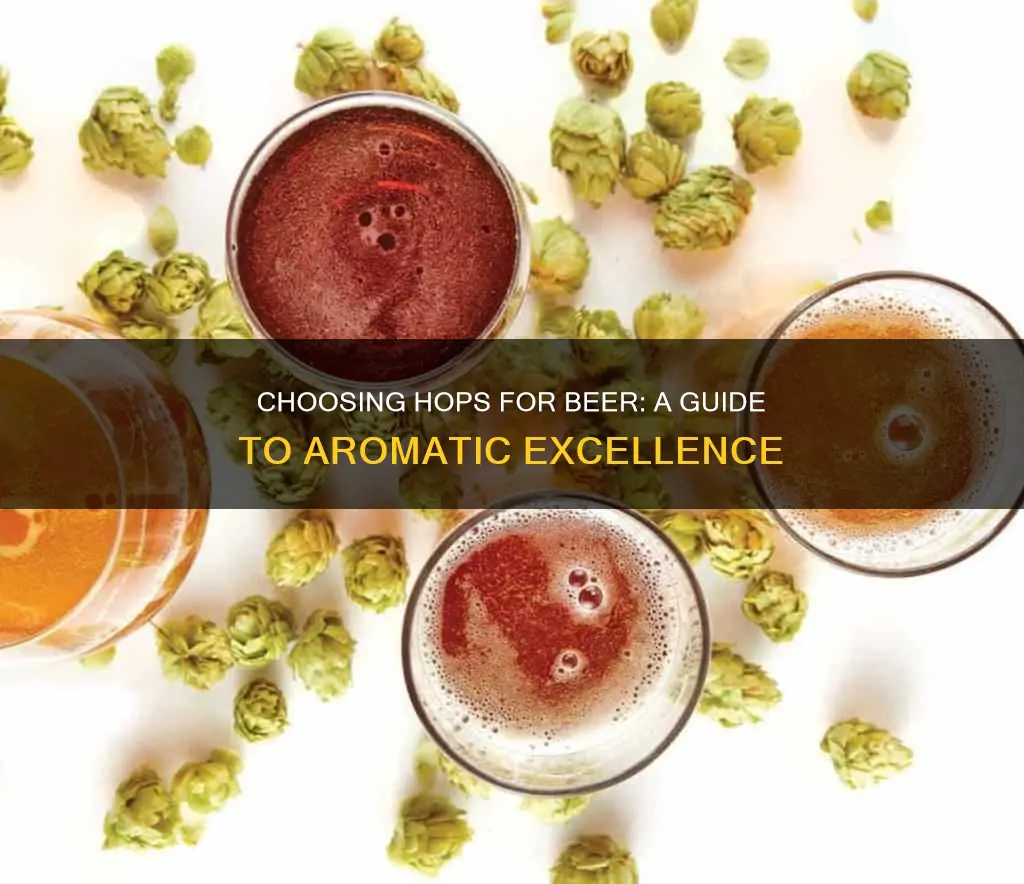
Choosing the right hops for your beer can be a challenge, especially with the wide range of varieties available. Hops are the green, cone-shaped flowers of the female hop plant, also known as Humulus lupulus. They are a key ingredient in beer, providing the primary bittering agent that brewers use to balance the sweetness of the grain. Hops also lend beers their signature flavours and aromas.
When choosing hops, it's important to consider the desired flavour profile and aroma of your beer. Different hop strains offer varying levels of alpha acids and essential oils, which contribute to bitterness, flavour, and aroma. For example, hops with high alpha acid content, such as Chinook, Columbus, and Cascade, are commonly used for bittering. On the other hand, hops with high levels of essential oils, like Simcoe, contribute more to the flavour and aroma of the beer.
Additionally, geography plays a role in hop selection. The three main categories of hops are Noble hops (from Germany and the Czech Republic), American hops, and English hops. Noble hops, including strains like Saaz and Tettnanger, are known for their low bitterness and high aroma, making them ideal for traditional European lagers. American hops, such as Cascade and Centennial, tend to be bold and highly aromatic, with prominent citrus and pine notes. In contrast, English hops, like Fuggle, have more delicate profiles with notes of earth, herbs, and spice.
To familiarise yourself with different hop varieties, it's recommended to sample single-hop beers or order small quantities of hops to analyse their aromatic profiles. By understanding the unique characteristics of each hop variety, you can create complex and delicious beer recipes.
| Characteristics | Values |
|---|---|
| Geography of origin | Noble hops (Germany and the Czech Republic); American hops (United States); English hops (England) |
| Common types | Noble hops (Saaz, Tettnanger); American hops (Cascade, Centennial); English hops (Fuggle) |
| Flavour and aroma | Noble hops (spicy, herbal, piney, floral, and subtle); American hops (citrus and pine notes); English hops (earth, molasses, herbs, spice, and wood) |
| Bitterness | Noble hops (low bitterness); American hops (high bitterness); English hops (medium bitterness) |
| Use | Noble hops (traditional European lagers); American hops (American ales); English hops (traditional British ales) |
What You'll Learn

Hop strains and their alpha acid and essential oil levels
When choosing hops for beer, it's important to understand the role of alpha acids and essential oils in different hop strains. Alpha acids are the main source of bitterness in beer, and hops can be broadly categorised into aroma hops, bittering hops, and dual-purpose hops based on their alpha-acid content. Aroma hops typically have less than 10% alpha acids, while bittering hops have a higher alpha-acid content, often between 10% and 20%. Dual-purpose hops, such as Citra, El Dorado, Simcoe, and Cascade, have both significant alpha-acid levels and essential oil content, allowing them to add bitterness and aroma to the beer.
Aroma hops, with their lower alpha-acid content, are best suited for late additions to the boil or for dry hopping. While they can still contribute some bitterness due to alpha-acid isomerisation at temperatures above 79°C (175°F), their primary role is to impart flavours and aromas. The essential oils in aroma hops are volatile and can quickly evaporate if left in the boil for too long, so they are often added during the whirlpool stage or after fermentation.
Bittering hops, on the other hand, are added early in the boil to maximise the extraction of alpha acids and increase the bitterness of the beer. Longer boil times lead to more alpha-acid isomerisation and a more bitter beer. Bittering hops also contribute to beer stability by adding antibacterial qualities, increasing the shelf life of the beer.
When selecting hops, brewers need to consider the desired flavour profile, the timing of additions, and the level of bitterness they want to achieve. Each hop strain has a unique combination of alpha acids and essential oils, resulting in distinct flavours and aromas. For example, the essential oils in hops can include myrcene, humulene, caryophyllene, and farnesene, each contributing different notes to the final beer. Myrcene, the most prominent oil, adds resinous pine, citrus, and fruity flavours. Humulene, the second most abundant oil, contributes woody, hoppy, and spicy notes. Caryophyllene adds black pepper, spicy, and herbal aromas, while farnesene, when present, imparts fresh, green, and woody aromas.
Additionally, some hops are known for their aromatic properties and are used to enhance the flavour and aroma of the beer. These hops may have a delicate spicy-herbal character, floral and citrus notes, or a combination of fruit candy and citrus grapefruit aromas.
Apple Cider Beer: Hops or No Hops?
You may want to see also

Hop strains by geography of origin
When it comes to choosing hops for your beer, there are a few things to consider. Firstly, hops can be classified as bittering hops, aroma hops, or dual-purpose hops. Bittering hops are added early in the boil, while aroma hops are added late in the boil or as a dry hop. Dual-purpose hops can be used at any stage of the beer-making process.
The origin of hops can also play a role in their flavour and aroma characteristics. Here is a breakdown of some popular hop strains by their geography of origin:
North America
North American hops tend to be higher in alpha acids, which contribute to bitterness. However, some varieties like Cascade, Chinook, and Columbus (also known as Tomahawk or Zeus) are known for their aromatic qualities and are often used in American Pale Ales and IPAs. Centennial is another popular American hop with strong citrus aromas.
United Kingdom
UK hops such as Fuggle and East Kent Goldings (EKG) are known for their earthy and spicy notes. EKG, in particular, is a classic English hop with a Protected Designation of Origin, grown exclusively in a designated area of East Kent. UK Challenger and Northdown hops are also popular for their bittering potential and fruity, tea-like aromas.
Germany
German hops often fall into the category of "noble hops", which are known for their high oil content and aromatic qualities. Examples include Hallertau Mittelfrüh, Tettnang, Spalt, and Hersbrucker. These hops are commonly used in German and European pale lagers. Northern Brewer is another popular German hop used in combination with other hops for bittering.
New Zealand
New Zealand-grown hops, such as Nectaron and Nelson Sauvin, have become popular for their intense fruity and tropical flavours. These hops are well-suited for use in American Pale Ales, either alone or in combination with complementary fruity hops.
Australia
Australian hops, like Galaxy and Enigma, are known for their intense flavours and aromas, often described as tropical and fruity. Galaxy, in particular, is a popular choice for its strong passion fruit and pineapple notes. Australian hops have gained popularity due to their unique flavour profiles.
Hops and Hormones: The Estrogen-Beer Link Explained
You may want to see also

Hop experimentation for flavour and aroma
Firstly, it is important to consider the type of hops being used. Different varieties of hops will have different flavour and aroma profiles, so choosing the right type of hops is essential. Brewers should research the flavour profiles of different hop varieties and select those that align with the desired flavour of their beer. In addition, the quality of the hops is important. Using fresh, well-packaged hops will result in better flavour and aroma extraction.
The amount of hops used will also impact the flavour and aroma. Larger amounts of hops will result in stronger flavours and aromas, but it is important to consider how the hops are being used, as simply adding more hops without thinking about their application can be ineffective. For example, adding hops for flavour during the boil can be counterproductive, as the flavour compounds can boil off. Instead, late hop additions, whirlpool or steep additions, and dry hopping are more effective methods for maximising hop flavour and aroma.
The timing of hop additions is crucial and requires experimentation. For whirlpool or steep additions, brewers should experiment with different temperatures and times to find the ideal conditions for extracting the desired flavour and aroma compounds. Lower temperatures and longer steep times tend to result in better extraction, but this can vary depending on the specific hops used. Dry hopping should occur early in the fermentation process to take advantage of biotransformation, which can lead to more citrusy and fruity aromas. However, dry hopping for too long can result in unpleasant vegetal and grassy flavours, so it is generally recommended to limit dry hopping to 3-4 days.
Finally, the form of the hops can impact flavour and aroma extraction. Pellet hops have been shown to impart flavour and aroma more quickly and efficiently than whole cone hops, and they also take up less storage space. However, it is important to note that dry hopping with pellets may increase polyphenol extraction, which can lead to increased bitterness, astringency, and oxidising agents.
The Ultimate Guide to Hops in Beer Brewing
You may want to see also

Suggested hop combinations
British Hops
British hops that work well together include Fuggle, East Kent Golding, Target, Challenger, and Northdown. Any of these varieties can be mixed to produce a good English ale, regardless of whether the beer is a brown ale, a bitter, or an ESB. Styrian Golding (a Fuggle of British ancestry grown in the Slovenian Republic) also complements English hops well when used in ales.
Continental Hops
Varieties of Hallertauer (Hersbrucker, Mittelfrüh, and Tradition), Tettnang, Spalt, and Northern Brewer combine well. Saaz hops, with their distinct spicy Zatec aromas (Zatec being the region of Czechoslovakia where Saaz is typically grown), can be used in almost any style of beer. They are often found in German and Czech Pilseners and even in Belgian and English ales.
American Hops
The "four Cs"—Centennials, Columbus, Chinooks, and Cascades—are noted for their symbiotic properties. While each brings its own bouquet to the table, all contribute an overall "citrusy" character that is often very desirable in pale ales and American IPAs. They are the trademark citrusy hops of the Pacific Northwest. Other American hops that work well together are Willamette, U.S. Fuggle, Yakima Golding, and Mt. Hood. The newer U.S. hybrids such as Mt. Hood, Liberty, and Ultra can be used in both ales and lagers, though some prefer the latter two for lagers.
Hop Acids' Intricate Influence on Beer's Flavor and Aroma
You may want to see also

Hop suggestions for different beer styles
When choosing hops for a beer recipe, it can be helpful to fall back on style appropriateness. For example, if brewing a continental lager, hops like Saaz, Tettnang, and Hallertau are often used. These hops are known for their spicy and floral characteristics. On the other hand, if brewing an English beer, East Kent Goldings are a popular choice for their delicious flavour, and if they're too assertive, Fuggles are a milder and grassier alternative.
For an American ale, Cascade hops are a common choice, while for an American IPA, high-AA hybrids like Chinook, Centennial, and Simcoe are often used. If you're feeling adventurous, you can also experiment with other varieties like Amarillo or Columbus.
When it comes to specific beer styles, here are some hop suggestions:
- American Barley Wine: California Cluster, Cascade, and Golding.
- American India Pale Ale (IPA): Admiral, Delta, Magnum, Amarillo, Cascade, Chinook, and Cluster.
- Belgian Farmhouse Ale: Admiral, Fuggle, Magnum, and Strisselspalter.
- California Blonde Ale: Calicross, East Kent Golding, Fuggle, and Cluster.
- Double India Pale Ale (DIPA): Hersbrucker and Hersbrucker G.
- English Barley Wine: Northdown, Target, East Kent Golding, and Fuggle.
- Extra Special Bitter (ESB): Blisk, Bobek, Calicross, Centennial, Fuggle, and Northern Brewer.
- Imperial India Pale Ale (IIPA): Admiral, Apollo, Bramling, Chinook, and Hallertauer Magnum.
- Russian Imperial Stout: Hallertauer Taurus and Hüller Bitterer.
- Triple India Pale Ale (IIIPA): Hersbrucker G, Hersbrucker E, Mount Hood, Amarillo, and Tettnanger.
Remember, these are just suggestions, and brewing beer is a creative process, so don't be afraid to experiment with different hop varieties to find unique flavour profiles that suit your taste!
Harvesting Hops for Beer: A Guide to Plucking the Perfect Cones
You may want to see also
Frequently asked questions
With a wide range of flavour and aroma characteristics, hops can be chosen based on the desired profile of the beer. Hops can be categorised by their geography of origin, with the three most prominent categories being Noble hops (from Germany and the Czech Republic), American hops, and English hops.
Classic hops include:
- Saaz (Czech Noble hop) - spicy, herbal, and piney characteristics with low bitterness.
- Tettnanger (Noble hop) - floral and spicy aroma with subtle black tea-like flavours.
- Hallertau (German Lager hop) - refined flavour and aroma, with a low alpha acid content.
- Cascade (American hop) - citrus and floral notes with moderate bitterness.
- Fuggle (English hop) - herbal, earthy, and spicy aromas with low alpha acid content.
Hops are added to the wort during the boil in stages to effect bitterness, flavour, and aroma. The timing and duration of boiling hops will impact the final product. A long boil (45 minutes to 1 hour and a half) is used for bittering hops, a medium boil (up to 30 minutes) for flavour hops, and a short boil (5 minutes or less) for aroma hops.
To experiment with different hops, it is recommended to start with a neutral recipe that accentuates the hop's contributions. Select a neutral base hop for bittering effects, then adjust one variable at a time, such as using a different hop for flavour and aroma. British hops that work well together include Fuggle, East Kent Golding, Target, Challenger, and Northdown. American hops that complement each other are the "four Cs": Centennials, Columbus, Chinooks, and Cascades, known for their citrusy character.



